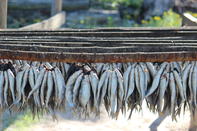Fish Industry
Saldanha Bay has a sizeable fishing industry. In 1956, the fishing in South Africa industry started to regulate itself by forming a company for the centralised marketing and sale of canned fish products.

Fishing companies in Saldanha are some of the largest employers of labour in the area, with giant factories lining the harbour. Factories are geared to unload and process cargo of fish that is brought in by fishermen who fish at great depths out in the ocean. Apart from processing and packaging fish, the factories produce instant meals, which are exported world-wide to countries as far as Norway and Russia. Some factories use ships with freezing facilities, where fish is processed on board.
Saldanha also has a dry fish industry, which has grown significantly over the years. One of the most popular dried fish products is the bokkom - salted, dried mullet - that is a cheap and practical source of protein. Dried fish has to meet specific requirements in terms of moisture content, salt concentration and other health standards.
SAS Saldanha

With strong historic military links, Saldanha is host to a Naval training base and the South African Military Academy. The base was built as a result of increased pressure on Table Bay harbour in 1944, and to ensure the Cape was adequately protected against enemy attacks. Guns were installed nearby the Bay and anti-submarine nets were laid in North Bay. The base became a training base in 1951 when the Naval Gymnasium was set up. The base was named SAS Saldanha in 1956 and became a fully-fledged naval base in 1989. It became a pure training unit in 1990.
The SAS Saldanha Nature Reserve offers a display of wildflowers during late winter and spring while Southern right whales also visit the waters in and around the nature reserve.
Port of Saldanha Bay
The Saldanha Bay port is South Africa’s largest natural harbour, which is partially protected by a long artificial breakwater. The port developed into a modern harbour only recently, when it became necessary to facilitate the export of iron ore from the Northern Cape. This is said to be the only really good natural harbour in South Africa, as all the other ports have required extensive dredging and re-working. Nevertheless, it is not a dirty or polluted port. The boats bobbing in the blue bay are very picturesque and the town of Saldanha is a thriving holiday destination.
The Saldanha-Sishen railway line, is also known as the Ore Export Line (OREX). It is an 861-kilometre-long (535 mi) heavy-haul railway line connects Sishen in Namaqualand to the Saldanha port. It is used to transport iron ore from the mines in Sishen - about 60 million tonnes per year. The line was built by Iscor (ArcelorMittal South Africa), a steel company, and opened in 1976. The line was transferred to Transnet Freight Rail in 1977, and runs on a single-track line with 19 crossing loops, fully electrified.